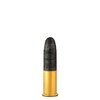I bought this IJ Supershot because the designer must have had me in mind when he designed it. It has my name all over it. It is in great shape and I would love it to be my 22 woods gun. Except it doesn't shoot worth a darn. It spits lead on every shot and cant beat a 2" square at 10 yards.

It doesn't lock up consistently. About half the time I can fire the gun and while holding trigger down I can turn the cylinder a tiny bit to full lock up. It is not a specific cylinder and one time a specific cylinder will lock up and another time it won't.
Before I tackle the timing I want to resolve a cylinder alignment issue. I'm not sure if this is the cause of the timing issue, a contributing factor, or unrelated. See the below photograph of the gap at the rear of the cylinder. The top is tighter than the bottom. I cannot photograph the forward cylinder gap as this cylinder has a forward lip.

I can measure the `arbor` that the cylinder rotates on and can measure 0.08" difference from the bottom of the top strap to the arbor from left to right in this picture. So the arbor is not parallel to the top strap.

My question is if this is or is a contributor to the timing issue. Keep in mind that I'm measuring using a set of calipers and there is room for error in the way I measured it. It could be more than the 0.08"

It doesn't lock up consistently. About half the time I can fire the gun and while holding trigger down I can turn the cylinder a tiny bit to full lock up. It is not a specific cylinder and one time a specific cylinder will lock up and another time it won't.
Before I tackle the timing I want to resolve a cylinder alignment issue. I'm not sure if this is the cause of the timing issue, a contributing factor, or unrelated. See the below photograph of the gap at the rear of the cylinder. The top is tighter than the bottom. I cannot photograph the forward cylinder gap as this cylinder has a forward lip.

I can measure the `arbor` that the cylinder rotates on and can measure 0.08" difference from the bottom of the top strap to the arbor from left to right in this picture. So the arbor is not parallel to the top strap.

My question is if this is or is a contributor to the timing issue. Keep in mind that I'm measuring using a set of calipers and there is room for error in the way I measured it. It could be more than the 0.08"













